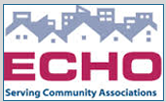Miscellaneous HOA Coverage
Business Personal Property
Business Personal Property (BPP) typically includes HOA furnishings or equipment used to maintain or operate the HOA that is not part of the structure. Examples include: clubhouse and swimming pool furniture, exercise equipment, common area or on-site office furniture, electronic components such as computers, peripherals, TV, stereo systems and or tools and equipment used to operate or maintain the buildings or grounds.
Establishing Insurable Building Value
Almost all Homeowner Association (HOA) Covenants Conditions and Restrictions (CC&Rs) require the Insurable Building Value to be set at 100% of full replacement cost (actual cost to rebuild at time of loss). Establishing a Building Value can be highly subjective as even different contractors using the same set of architectural plans will arrive at different construction values. Therefore, the HOA board should complete their due diligence prior to establishing the building insurance value. Ask your agent to complete a Marshall Swift software estimate of building value for your review. Call local contractors who build condominiums and townhouses or ask local architects for their opinion of local construction costs. Also, take into account if you have just one large building or a few buildings with only a small distance between buildings where a fire could easily jump thereby creating a total loss as compared to an HOA with multiple buildings and lots of open space between the buildings.
Coinsurance & Agreed Value
If the insurance company agrees with the Proposed Insurance Building Value, and if so requested, the insurance company will waive Coinsurance. Coinsurance is a penalty that is applied when a property damage claim occurs and the building is under-insured. Coinsurance penalties are typically applied when a building is insured for less than 80% of the actual cost to reconstruct the buildings. However, the Coinsurance penalty can also be applied if the insurance is less than 90% or 100% of the Full Replacement Value, depending on the policy language. The safest way to avoid a Coinsurance penalty is to maintain your Building Valuation at 100% of the current Replacement Cost. Other solutions are to have your agent ask the insurance carrier to waive Coinsurance and or add an Agreed Value endorsement.
Valuation: Replacement Cost Value VS Actual Cash Value:
If your policy is written on a Replacement Cost basis, your property damage claims should be paid in full without deducting depreciation. However, some agents quote their policies on an Actual Cash Value basis (ACV) which reduces the cost of the insurance and makes their quotes look cheap in order to win the business. Yes, the ACV policy is cheaper, but you will be shocked when your claim is not paid in full by your insurance carrier. I’ve seen this happen. The unit owners and HOA members Yelp! against the insurance company but don’t realize that it was really their agent who either didn’t understand how the coverage works or just wanted a cheaper quote to win the business!
Sewer Drain Back Up Coverage
A Sewer Drain Back Up is typically caused by a plugged sewer line that backs up sewage water into a unit owner’s premises because other up-stream users continue to use toilets, sinks and showers. However, a sewer drain back up can also be caused when the city’s main sewer line becomes blocked which can then reverse flow, potentially flooding multiple units. Most HOA policies limit the amount of sewer back up coverage so have your personal agent include additional coverage on your HO6 unit owner’s policy.
Earthquake Sprinkler Leakage Endorsement
If your HOA contains fire sprinklers inside common area interior hall ways or inside individual units, request that the Hazard Insurance Policy include an Endorsement for Earthquake Fire Sprinkler Leakage if the policy offers this coverage.
Property Damage Claims Payment Process
Most property damage claims are paid in at least two payments: An initial payment is made after the Contractor and Claims Adjuster have initially agreed on Scope of Work and agreed on the cost of time and materials to complete the work. This initial payment is typically paid on an Actual Cash Value (depreciated) basis. As work progresses the contractor may discover additional damage and submit a Change Order to the Claims Adjuster for approval which would then also be paid on an ACV basis. After all work is complete and the contractor and HOA (unit owner) submit a Notice of Completion to the Adjuster, the Adjuster will make a final payment representing the value of depreciation that was initially held back. Unit owners can pay the contractor directly for the value of any improvements and betterments (upgrades) the unit owner wants installed during the repair process.
Hired and Non-Owned Vehicle Insurance for Homeowners Associations
If properly endorsed, General Liability can also insure liability risk for Non-Owned and Hired Vehicles. Examples can include the Homeowner Association Board Member’s vehicles if a Board Member is driving somewhere on behalf of the Association when an accident occurs. Non-Owned vehicles could include an accident that occurs in a truck that the HOA landscape committee might rent to complete a small landscape project. Vehicles owned by the Association should be included under General Liability Automobile Coverage.
Loss of Business Income/Maintenance Fees for Homeowners Associations
If an insured loss causes a unit owner to move out of their home, the unit owner will have to pay rent at a second location and is obligated to continue paying their monthly HOA Dues. However, if this situation causes a financial hardship, the HOA policy may pay the monthly dues on behalf of the displaced unit owner.






